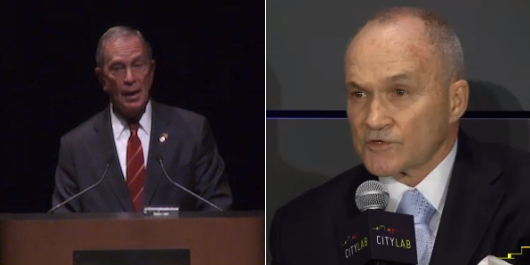
In a moment that crystallized the schizophrenic traffic safety policies of the Bloomberg administration, Mayor Michael Bloomberg and Police Commissioner Ray Kelly revealed completely different philosophies concerning New York City's streets while speaking at two different conferences this morning.
Bloomberg, at the International Downtown Association annual meeting, spoke about the safety gains, economic benefits, and popularity of initiatives like plazas, bike-share, and protected bike lanes. He started with Times Square, which has seen rents and sales receipts continue to rise after plazas were installed.
"Pedestrians who were once crammed for space and constantly got hit by cars are far safer," Bloomberg said. "And that's not only far more relaxing and pleasant, it also translates into major economic benefits."
But it's not just plazas, Bloomberg said, touting protected bike lanes that encountered initial opposition from some merchants who were worried about losing drive-by customers. "In most of these cases, we didn't allow you to stop and jump out of your car and shop, so you weren't exactly losing anything," Bloomberg said. "Progress never comes easy. People are comfortable with what they have, and anything new is worrisome."
Bloomberg also said bike-share is "off-the-charts successful," despite an avalanche of negative press before it launched. "Today, all the reporters and even the publishers ride the bicycles," he said.
"Lots of neighborhoods want us to close the streets to automobile traffic and turn them into pedestrian malls. Unfortunately, we still need to have streets open for trucks, for buses, and for cars, and so it's a fine balance," said Bloomberg. "The truth of the matter is, the more you make a neighborhood friendly, the better it is for the people that live there, who visit, and the merchants."
A few minutes earlier at the CityLab conference, Ray Kelly was asked a question by Sarah Goodyear, reporter for Atlantic Cities and Streetsblog alumna, about the NYPD's approach to traffic safety. "There's a perception that a lot of drivers don't get prosecuted for criminal activity," said Goodyear. "Do you think the NYPD could be doing a better job of preventing traffic violence on the street, and how could they do that?"
Kelly took a different line on traffic safety than his boss. "We could always do a better job in every area," he said, noting that the force has less manpower than it did a decade ago. But contrary to the supposed new attitude toward traffic violence at NYPD, Kelly also said "accidents" are a fact of life. "We do have 8.4 million people here. We do have a daytime population that's over 10 million people, so you're going to have a lot of traffic. And you're going to have accidents."
"We've worked closely with Commissioner Janette Sadik-Khan; I think they're doing a great job," Kelly said, mispronouncing his fellow commissioner's name as "Sadiki-Khan."
Kelly defended NYPD crash investigation procedures and the partial reforms enacted last spring, but when it comes to cracking down on reckless drivers, the commissioner said there was little police could do. "Many of the advocates, and I assume you are one of them, want us to make these determinations when we haven't observed the violation," Kelly said. "It takes in-depth examination of a violation. It takes witnesses. It is much more complex than you might think."
A bill to change state law so it explicitly states that officers do not have to personally witness an infraction in order to issue a careless driving summons cleared the State Senate this year but failed to pass in the Assembly. Although an NYPD lawyer testified last week that the department supports this bill, Kelly did not mention it during his remarks today.
Responding to a follow-up question about using cameras and technology in traffic enforcement, Kelly said the department has installed dashboard cameras in its highway patrol cars, but did not mention automated enforcement of red light running or speeding.





